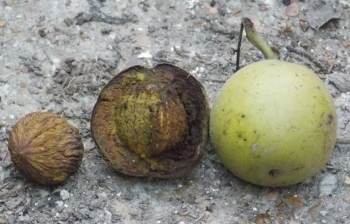Oak; Live Oak Quercus virginiana Mill;. Dallas is beyond the northern edge of the natural range of live oaks, but the trees grow here if planted and watered for the first few years. The deeply furrowed, rough, black bark of this readily branching evergreen contrasts with the glossy dark green of its small (<2”) evergreen leaves, which depending on the variety, range from slightly curled with sharp holly-like points, to smooth and elongated ovals. The leaves last for two or more years, older leaves shedding in the spring just before new leaves grow in (mid-March). Live Oaks reproduce from catkins, tiny spikes of miniscule flowers, a few of which convert to acorns that are much longer than most oaks, often turning bronze in color after they fall. The slow growth, spreading growth pattern, drought resistance and evergreen qualities make this tough, dense-wooded tree a favorite for large yards or campuses. Though the long, drooping, habit of new growth gives this oak a scraggly look when young, it usually grows wider than tall, achieving a manicured, rounded profile. The tough, dense, springy wood, favored by ship-builders, allows the branches to extend far outward, making them safe for kids to climb in without fear they will breaking. The leaves and bark, are so heavy with tannin that they do not make good mulch. The acorns, longer than other types of oak, end in a terminal spike, and held in exceptionally small caps, are green when they fall, but soon turn a rich brown. They sprout easily, if they escape acorn weevils, and form an enlarged, woody, tuber-like base just underground which preserves young tree through dry periods. Light brown, woody galls caused by tiny wasps, form on twigs. (170-171) 4/10/15; 3/26/16-4/15/17; 3/22/18 – 4/10/18; 3/25/19 – 4/20/19; 3/25/20 – 4/17/20;

Live Oak habit; a slow growing, evergreen oak that branches readily, with dark grey to black, deeply furrowed (or cubed), corky bark, and very dense, springy, hard wood that produces elongated, rich brown colored acorns.

Note; nearly black, deeply furrowed, corky bark, often broken into cubes, rather than ridges, with a spreading habit

Note; long, tough, dark green leaves, sometimes with tooth-like projections along the margins, which shed just before catkins and new growth appear in the spring
Note; fuzzy catkins which emerge just as the tree is budding new, wispy growth with fresh leaves

Note; grey stem galls caused by a tiny wasp. These are not the fruit of the tree

Note; acorns are long and thin, with a sharp tip, and a very small cap, green when they fall, but turning a rich brown after a few days.
Note; rich brown color, extra small cap, elongated form, and tiny hole where a wevil larva exited.














































